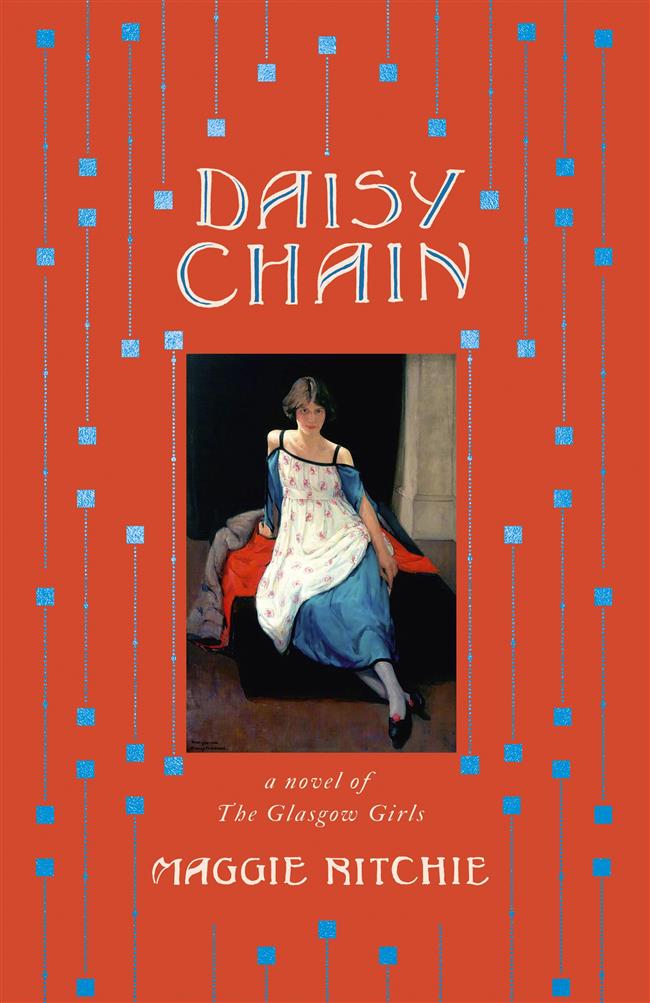Award-winning Scottish author's latest novel set in 1920s Shanghai

Daisy Chain, published by Two Roads, can be obtained here: https://www.amazon.co.uk/Daisy-Chain-novel-Glasgow-Girls/dp/1529366380
Don't judge a book by its cover," is a well-worn idiom first coined by 19th century novelist George Eliot. And this is certainly the case with Maggie Ritchie's latest novel Daisy Chain. The cover, designed by Scottish artist Dorothy Johnstone, looks rather quaint at first glance, and evokes a sense of innocence and naivety. Yet, turn inside and the award-winning author takes readers on a dark, mysterious, and cruel journey at times, with an unexpected twisted narrative.
Daisy Chain is a novel Eliot, Jane Austen or the Bronte sisters would have penned had they been born in 20th century Glasgow, brought up listening to the Bay City Rollers, and The Clash. Don't be fooled by the musical juxtaposition, the novel's main protagonists, Lily and Jeanie, like the rock and pop bands, couldn't be any more different. Lily, an only child of two loving middle-class parents, and Jeanie, one of ten children from a broken home in a struggling lower working-class environment. Class differences aside, the two girls bonded at school in spirit, friendship, and ambition: Lily to be an artist, Jeanie to be a dancer.

ABOUT THE AUTHOR:
Maggie Ritchie is a journalist who was awarded a grant to do her research for Daisy Chain in Shanghai. Her debut novel, Paris Kiss (2015), won the Curtis Brown Prize, was runner-up for the Sceptre Prize and longlisted for the Mslexia First Novel Competition. The German edition has appeared on bestseller charts, and the novel has also been translated into Czech. Her second novel, Looking for Evelyn, (2017), was shortlisted for the Wilbur Smith Adventure Writing Prize for Best Published Novel 2018.
The author was inspired by real-life artist Eleanor Allen Moore, a pioneering woman painter who defied convention to make her way in a man's world before leaving Scotland for Shanghai in the 1920s.
"Eleanor Allen Moore was a talented artist from a group known as the Glasgow Girls," the Curtis Brown Prize winning author said. "The Glasgow Girls, who were students and teachers at Glasgow School of Art around the turn of the last century, achieved fame at the forefront of Scotland's Art Nouveau movement, only to sink into obscurity, their ground-breaking work shunned by the art world.
"They were rediscovered in the 1980s, and it was at an exhibition in 2010 that I first saw their work. I was swept away by their romantic book illustrations, embroidered panels, and striking paintings among many other things. Eleanor Allen Moore's self-portrait was chosen for the exhibition poster, which caught my eye. Bright eyed and full of spirit, I had to find out more about her, and wasn't disappointed. Her amazing life inspired my heroine who, like the real artist, attended Glasgow School of Art before traveling to China with her husband, a doctor, and their daughter."

Eleanor Allen Moore self-portrait
Following the success of her first two novels, Paris Kiss and Looking For Evelyn, the writer was awarded a Society of Author's grant to research her third book, and set off, embarking on an adventure to research the artist's exotic life in the busy metropolis, and follow in her famous footsteps.
"Eleanor and her husband, Dr Robert Cecil Robertson, and their infant daughter Ailsa sailed to Shanghai in 1925 for Robert to take up an appointment in Public Health," Ritchie said. "To begin with it was a difficult and dangerous time as there were serious anti-foreigner riots. Eleanor's husband was even abducted once but managed to escape from the kidnappers' car with a bullet hole through his coat. But when things settled down it was possible for them to explore the Yangtze Delta region in their houseboat and visit the ancient walled cities of Soochow (Suzhou) and Wusih (Wuxi).
"I stayed in the (former) French Concession, just off Huaihai Road – Avenue Joffre in Eleanor's time – and was bowled over by the European style buildings and the plane tree-lined boulevards. They reminded me of Paris and Madrid. Like Eleanor, I admired the shops along Nanjing Road E., which was known as Bubbling Well Road, and the department stores she would have frequented, such as Sincere and Wing On's. I spent days wandering the streets, walking in Eleanor's footsteps, peering into the crowded alleys and seeing the sights, sounds, and smells that would have become familiar to her.

"Chinese Children" by artist Eleanor Allen Moore
"The first sight Eleanor would have been greeted with upon arrival after six weeks on a Glasgow steamer, was the imposing grandeur of the trading houses, banks, and grand hotels of the Bund. The opposite bank of the Huangpu River fascinated me and the curve of immaculately preserved Beaux Arts buildings. This was where wealthy, pleasure-seeking foreign taipans carried out their business before relaxing at the Long Bar in the Shanghai Club, ordering crates of champagne by the dozen. They and their wives and mistresses amused themselves with a social whirl of glittering balls, betting on the thoroughbreds at Shanghai Race Club, and dancing at swanky nightspots where jazz bands played through the night."
Shanghai became known as "The Paris of the East," and the New York of the West," during the glamorous 1920s and 1930s. But at the same time, the metropolis also had a dark, seedy side. It was once a dangerous place, with a criminal underbelly run by warlords and vicious gangs.
"Much like Glasgow at the time, there was a huge disparity between the rich merchants and the poor who toiled long hours for pitiful wages in the factories, pulled rickshaws, and served the foreigners, and the wealthy Chinese with their Westernized first names, their wives and daughters dressed in the latest Paris fashions and hair marcelled and bobbed," the 57-year-old author said.

"Chinese Actor" by artist Eleanor Allen Moore
"As I marveled at Frenchtown's mock Tudor villas, and at the luxurious Art Deco hotels, I began to understand why Shanghai in 1921 saw the birth of the Communist Party of China, just as Glasgow's popular protests and radicalism in the same period led it to become known as 'Red Clydeside.'
"Despite this background of unrest, daringly, Eleanor braved the walls of Shanghai's Chinese old town, dashing off street scenes of people playing cards or Mahjong over green tea, as they still do in the parks, and lilongs I wandered through. She also ventured into the notorious opium dens to sketch those smoking languidly inside.
"Eleanor painted the landscapes and townscapes they sailed to, so it was a delight to travel to Suzhou, by bullet train not boat, and see these quaint canals, pagodas, and arched bridges for myself. I also visited Hangzhou, a UNESCO world heritage site and was taken with the grey-blue expanse of West Lake and heavenly Phoenix Mountain.

"Suzhou" by artist Eleanor Allen Moore
"I was so glad I had the opportunity to experience this and gain insights into 1920s Shanghai with the help of Patrick Cranley of Historic Shanghai, and John D Van Fleet from the Royal Asiatic Society of Shanghai. Patrick told me all about the life of foreign women like Eleanor, who with their cars, domestic staff, amahs, chauffeurs and gardeners, enjoyed great freedom from household chores and child-minding. But unlike other expatriate wives, Eleanor used this time to observe the world around her and paint it.
"Eleanor's independent spirit and courage were typical of the colourful Glasgow Girls, who clashed with respectable society, and I brought elements of their strong characters into my novel, which spans a period of dramatic change from 1909 to 1929 and moves between Kirkcudbright in southern Scotland, Glasgow and Shanghai.
"There are many more amazing Glasgow Girls, each of them breaking new ground in their own inimitable style and living life as they wanted. I hope I have managed to capture their courage and spirit of adventure in my book, and would love it if their art could be admired once more, and if more people could discover the charms of old Shanghai."
Will Scott is a Shanghai-based journalist and author of "Pavel Is a Geordie."















